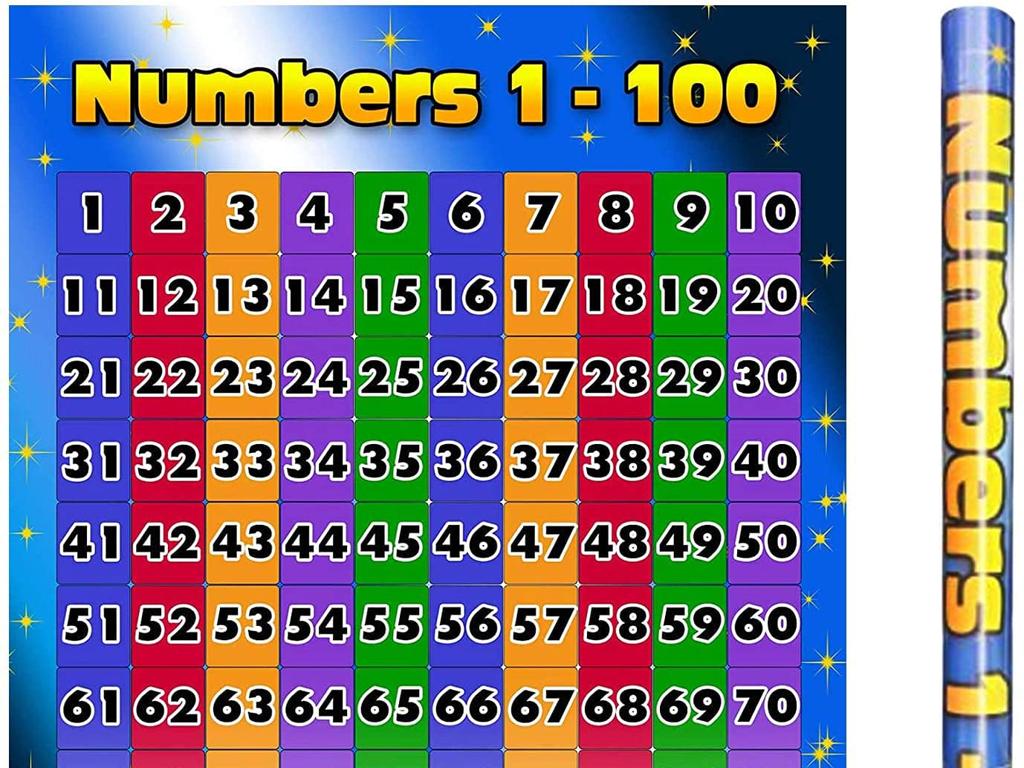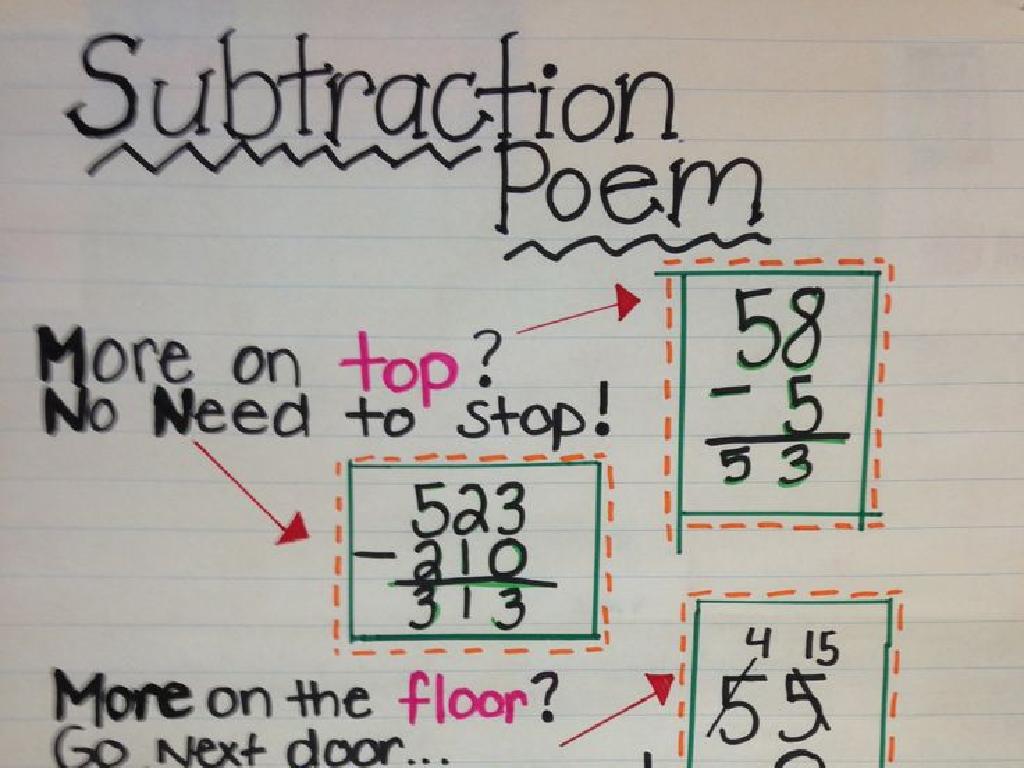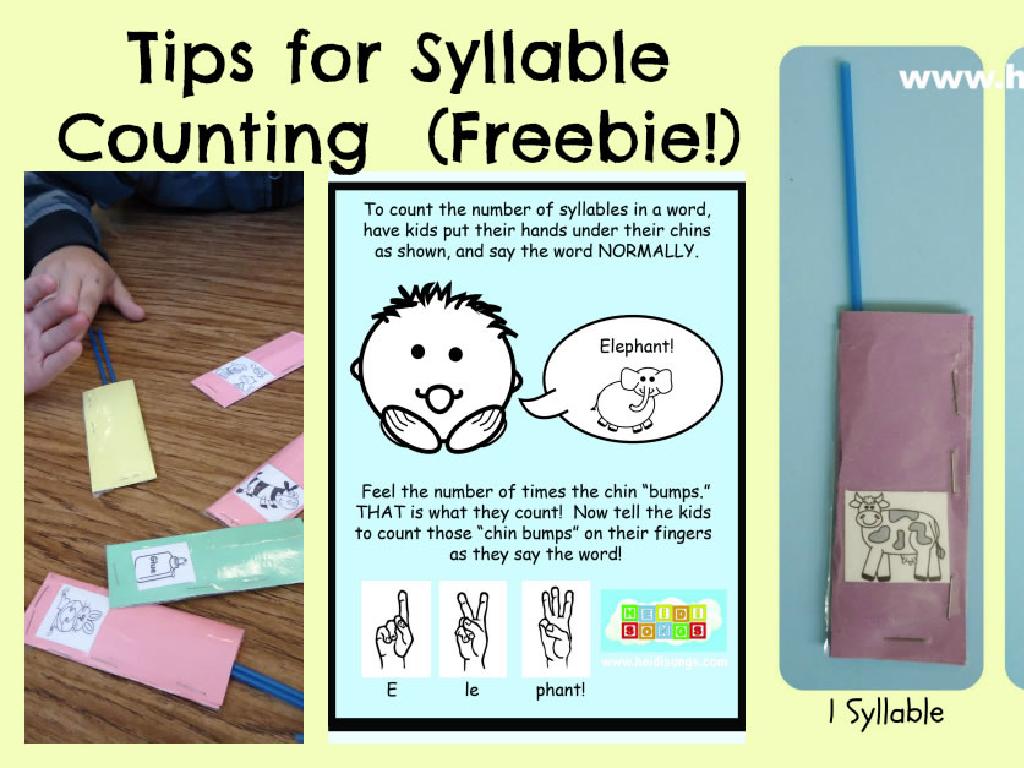Compare And Convert Customary Units Of Volume
Subject: Math
Grade: Fifth grade
Topic: Customary Units Of Measurement
Please LOG IN to download the presentation. Access is available to registered users only.
View More Content
Understanding Customary Units of Volume
– What is volume?
– Volume measures how much space an object takes up.
– Customary units for volume
– Units include teaspoons, tablespoons, cups, pints, quarts, and gallons.
– Everyday objects and volume
– A teaspoon of medicine, a cup of milk, a gallon of paint.
– Converting between units
– How many cups are in a pint? Convert quarts to gallons.
|
This slide introduces students to the concept of volume and its measurement in customary units, which are commonly used in the United States. Start by explaining volume as a measure of the space occupied by an object, using examples like a box or a water bottle. Introduce the various units of volume, such as teaspoons, tablespoons, cups, pints, quarts, and gallons, and provide everyday examples for each to help students visualize the sizes. Discuss the importance of being able to convert between these units, especially in practical situations like cooking or measuring liquids for a recipe. Provide conversion charts or rules as a reference for students to use during exercises or homework.
Exploring Volume: Measurement in Daily Life
– What is volume?
– Volume measures how much space an object takes up.
– Volume around us
– Measuring cooking ingredients, filling a pool, or using a water bottle.
– Common volume units
– Cups, pints, quarts, and gallons are used to measure liquids.
– Converting volume units
– Learn how to change between cups, pints, quarts, and gallons.
|
This slide introduces the concept of volume, which is a fundamental measurement in both math and daily life. Start by defining volume as the amount of space an object occupies, typically in three dimensions. Provide relatable examples such as cooking or filling a container with liquid to illustrate the concept. Discuss the customary units of volume used in the United States, including cups, pints, quarts, and gallons, and how they are commonly used in everyday scenarios. Emphasize the importance of being able to convert between these units, as this skill is essential for recipes, science experiments, and many other practical applications. Include practice problems for students to convert between the different units to reinforce their understanding.
Customary Units of Volume
– Teaspoons, tablespoons, fluid ounces
– Smallest volume units in cooking, e.g., 3 tsp in 1 tbsp, 2 tbsp in 1 fl oz
– Cups in a pint, pints in a quart
– 2 cups in a pint, 2 pints in a quart, helps measure larger volumes
– Quarts in a gallon
– 4 quarts in a gallon, think of a milk jug
– Visualizing volume units
– Use pictures or containers to show how units fit into each other
|
This slide introduces students to the customary units of volume commonly used in the United States, focusing on their relationships and conversions. Start with the smallest units used in cooking, such as teaspoons, tablespoons, and fluid ounces, and explain how they can be converted into each other. Then, discuss larger units like cups, pints, quarts, and gallons, emphasizing the number of smaller units that make up the larger ones. Use visual aids like diagrams or actual measuring cups and containers to help students understand how these units fit together. Encourage students to visualize the units by relating them to everyday objects, such as a milk jug for a gallon. This will help them better grasp the concept of volume and its practical applications in daily life.
Converting Units of Volume
– Convert smaller to larger units
– Divide the volume by the conversion factor
– Convert larger to smaller units
– Multiply the volume by the conversion factor
– Learn conversion factors
– 1 cup = 8 ounces, 1 pint = 2 cups
– Tips and tricks for easy conversion
– Remember ‘Gallon Man’ or use a conversion chart
|
This slide aims to teach students the methods to convert between different customary units of volume. When converting from smaller to larger units, they should divide by the conversion factor (e.g., converting ounces to cups). Conversely, converting from larger to smaller units requires multiplication by the conversion factor (e.g., converting gallons to quarts). It’s crucial to memorize key conversion factors, such as how many ounces are in a cup or how many cups are in a pint. To assist with conversions, students can use mnemonic devices like ‘Gallon Man’ or keep a conversion chart handy. Practice problems can be given for homework to reinforce these concepts.
Real-life Examples: Customary Units of Volume
– Gallon jug of milk
– Commonly used for large liquid quantities in the U.S.
– Quart of soup
– Smaller than a gallon, often used for liquids like soup
– Comparing volumes
– Understand which container holds more and why
– Conversion practice
– Learn to convert between gallons, quarts, pints, and cups
|
This slide aims to help students grasp the concept of volume using customary units through tangible, everyday examples. A gallon jug of milk represents a larger volume that students are likely familiar with, while a quart container of soup illustrates a smaller, yet common, volume. Encourage students to think about how many quarts are in a gallon and to visualize the difference in size. This will set the stage for comparing volumes and understanding the relationship between different units. Conversion practice will reinforce their understanding by converting between gallons, quarts, pints, and cups. Use real containers if possible to demonstrate the concepts visually and make the learning experience more interactive.
Converting Customary Units of Volume
– Convert cups to pints
– Remember: 2 cups = 1 pint. How many pints are in 6 cups?
– Convert pints to quarts
– Keep in mind: 2 pints = 1 quart. Can you convert 4 pints to quarts?
– Convert quarts to gallons
– Use this: 4 quarts = 1 gallon. Find out how many gallons are in 8 quarts.
|
This slide is aimed at providing practice problems for students to help them understand the conversion between different customary units of volume. Start by explaining that these units are part of the customary system of measurement used in the United States. For each conversion, provide a clear example and then a problem for them to solve. Encourage students to memorize the basic conversion rates, such as 2 cups in a pint, 2 pints in a quart, and 4 quarts in a gallon. These practice problems will help solidify their understanding of volume conversions. Make sure to go over the answers in class and address any misconceptions or difficulties the students may have.
Class Activity: Volume Conversion Relay
– Divide class into teams
– Each team converts volume units
– Teams tackle gallons to quarts, quarts to pints, etc.
– First team to finish correctly wins
– Ensure accuracy and teamwork
– Review winning team’s answers
– Discuss the correct conversions as a class
|
This activity is designed to make learning about volume conversions interactive and fun. Start by dividing the class into small groups, ensuring an even distribution of skill levels across the teams. Assign each team different units of volume to convert, such as gallons to quarts, quarts to pints, pints to cups, and cups to fluid ounces. Use a variety of conversion problems to challenge the students. The first team to complete their conversions accurately wins the relay. After declaring the winning team, review their answers with the entire class to reinforce the learning objectives. This will help all students to understand the conversion process and verify their own work. Encourage students to work together and support their teammates. This activity not only teaches math skills but also promotes collaboration and healthy competition.
Lesson Recap: Customary Units of Volume
– Reviewed volume measurement
– Importance of understanding volume
– Knowing volume helps in cooking, science, and more.
– Homework: Conversion practice
– Complete the worksheet to convert between cups, pints, quarts, and gallons.
– Keep practicing at home!
|
As we conclude today’s lesson, we’ve revisited the key concepts of measuring volume using customary units such as cups, pints, quarts, and gallons. Understanding volume is crucial for real-life applications like cooking, storage, and scientific measurements. For homework, students are assigned a worksheet to reinforce their skills in converting between different volume units, ensuring they can apply what they’ve learned in practical situations. Encourage students to continue practicing these conversions at home to build confidence and proficiency in the topic.






